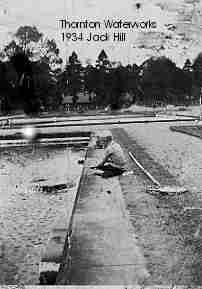|
Jack Hill tells us about his maternal grandparents:
Grandfather, Alfred Jordan and his wife Sarah (Nee Varnham of Appleby Magna) moved in 1890 from Desford, where he had been a farm labourer, to Thornton, to work at the waterworks which had been completed in 1854. They took their three children Mary Elizabeth, William George, and Annie born 1887, with them.
Soon afterwards, I believe, he took the post of superintendent and was allocated the tied house located on site. Despite being at the foot of the high earth dam holding back millions of gallons of water, no real thought was given to the potential danger.{Justified as it turns out to date}
The house had three bedrooms, kitchen, lounge and parlour, an outside WC but no bathroom. Later on, a bath was installed in the kitchen and provided with a lift-up cover of boarding. The bath was even provided with hot and cold water supply. Sewage disposal was via a septic tank in the garden.
The water works was laid out in a formal pattern with four filter beds surrounding an open collecting tank for the clean water into which a regulated quantity of chlorine was fed. Two more beds were located alongside the house with another wash tank between them.
The filter beds had a thick layer of sand above inverted clay tiles and the top four inches {100mm} was regularly removed by workers with shovels, then barrowed along boards laid on the sand up an incline to the wash tanks.
These were cast iron containers with an inner tank and overspill so that raw water could be allowed to flow through whilst the sand was being agitated with heavy iron hand rakes This removed the algae and after a fast rinse the sand was then barrowed back to the bed and spread
evenly ready for refilling with water. | 
| The raw water was allowed to flow out of a bell-shaped pipe to give some aeration. One of the beds had a cascade arrangement to add to the aeration. All of them had an outfall pipe, also bell-shaped, which kept the water sweet by allowing a small runoff which kept the down side stream still active.
Draining of a bed prior to cleansing was always a time of anxiety for me, as the small fish which had been living quite happily in the bed after being sucked through the siphon were suddenly deprived of habitat, and unless rescued were about to flap their lives away very quickly. I could only dash in and collect fish in a bucket and throw them into the trickle downstream.
Almost certainly most would die as a result of being put into a different environment but at least I felt I had to try. When I was not around, the death scene prevailed. Sentiment was something not usually bestowed on
small creatures and I presume that that had been the case for all the 40 years before I arrived on the scene.
The room containing the chlorine bottles and the injector apparatus was accessed via a locked door in the workers' tool shed and rest room. The smell of a coke fire for the water boiler to keep the chlorine at an even temperature mingled with the slight seepage of gas. It fell to the superintendent to connect the gas bottles, a job to be done whilst wearing a gas mask for safety. After the chlorine treatment, the clean water flowed by gravity to the pumping station at Desford Station from where it
flowed to Leicester and up into Desford.
Grandfather lived at Reservoir House until he retired but died when he was 68. His son William took over the post and carried on the work until his retirement in 1942.
| |


